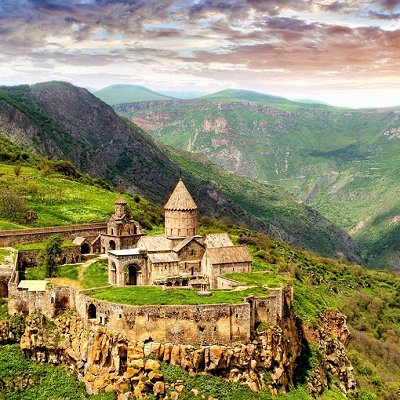
Like us on Facebook
PLACE NAMES



|
| Yeghegnadzor |
 |
|
Yeghegnadzor is a town and urban municipal community in southern Armenia, serving as the provincial capital of Vayots Dzor Province and the Yeghegnadzor Municipality. It is located at a road distance of 123 km (76 mi) south of the capital Yerevan, on the shores of Srkghonk River, at a height of 1,194 meters (3,917 ft) above sea level.
As per the 2016 official estimate, Yeghegnadzor had a population of around 6,600. As of the 2011 census, the population of the town was 7,944. Yeghegnadzor is the seat of the Diocese of Vayots Dzor of the Armenian Apostolic Church.
The name Yeghegnadzor consists of two Armenian words: yegheg meaning cane, and dzor meaning valley. Thus, the name of the town means "valley of canes".
The settlement was first mentioned as Pondzatagh during the 5th century. Historically, it belongs to the Vayots Dzor canton of Syunik; the 9th province of Greater Armenia (Armenia Major). However, the excavated layer of a cemetery and the remains of a mausoleum from the 1st millennium BC testify that the area has been settled long before the 5th century. The remains of the Urartian fortress near the town dates back to the 7th century BC.
According to historical records from the 1st quarter of the 9th century, when Syunats Prince Philip, son of Vasak, moved his residence from Sisian to Vayots Dzor and fortified in Yeghegis, the name Yeghegnadzor or Yeghegyats Dzor spread across the entire province. During the Middle Ages, the Silk Road passed through the area of Vayots Dzor, particularly the road that currently links the town of Martuni with Yeghegnadzor. Many significant churches, monastic complexes, bridges and caravanserais were built in the region between the 10th and 13th centuries, when Yeghegnadzor was part of the Kingdom of Syunik under the rule of the Siunia dynasty.
At the beginning of the 16th century, Eastern Armenia fell under the Safavid Persian rule. The territory of Yeghegnadzor became part of the Erivan Beglarbegi and later the Erivan Khanate. The period between the 16th and 17th centuries is considered to be the darkest period in the history of Yeghegnadzor. The region was turned into a frequent battlefield between the invading troops of the Turkic and Iranian tribes. As a result, many significant monuments and prosperous villages were destroyed and the population was displaced. In 1747, Yeghegnadzor became part of the newly-formed Nakhichevan Khanate. By the beginning of the 19th century, Yeghgnadzor was known as Keshishkend.
As a result of the Treaty of Turkmenchay signed between the Russian Empire and Persia in 1828 following the Russo-Persian War of 1826–28, many territories of Eastern Armenia -including Vayots Dzor- became part of the Russian Empire. In 1828-30, many Armenian families from the Iranian towns of Salmas and Khoy were resettled in Eastern Armenia, particularly in the areas that later became part of the Erivan Governorate in 1840. The first wave of Armenian settlers arrived in the Vayots Dzor region in 1828-29. In 1870, Yeghegnadzor became part of the newly-formed Sharur-Daralagezsky Uyezd of the Erivan Governorate within the Russian Empire.
Between 1918 and 1920 it was included in the short-lived Republic of Armenia. After the Sovietization of Armenia, the town became one of the predominant centres of the resistance against the Soviet rule and formed the unrecognized Republic of Mountainous Armenia under the leadership of Garegin Nzhdeh. However, after falling to the Bolsheviks in July 1921, it became part of the Armenian SSR.
The town was known as Keshishkend until 1935 when it was renamed Mikoyan after the Bolshevik leader Anastas Mikoyan. On 6 December 1956, the town was renamed Yeghegnadzor, restoring its historical name.
Following the independence of Armenia in 1991, Yeghegnadzor became the capital of the newly-formed Vayots Dzor Province as per the 1995 administrative reforms.
|
 Feel free to Email me any additions or corrections Feel free to Email me any additions or corrections
LINKS AVAILABLE TO YOUR SITE
| |





